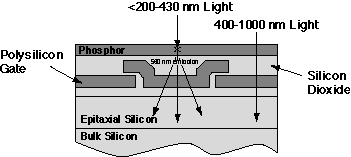

Metachrome II and Lumogen are composite phosphor coating developed by Photometrics and Princeton Instruments to improve sensitivity of CCDs in blue-visible and ultraviolet wavelengths. The application of a 0.4 to 0.6 nm thick coating of Metachrome/Lumogen to the surface of a CCD effectively, reliably, and inexpensively achieves a dramatic increase in device sensitivity in the 120 to 430 nm range. Both front-illuminated and back-illuminated CCDs will achieve improved UV response using Metachrome/Lumogen.

Optical Properties
the UV coating emits light at approximately 540 to 580 nm when
excited with light of wavelengths shorter than 450 nm. The high
conversion efficiency of the coating combined with the high quantum
efficiency of CCDs at the emission wavelength makes Metachrome/Lumogen
an ideal ultraviolet downconverter for silicon detectors. At wavelengths
longer than 460 nm, the thin layer of the UV coating becomes transparent
and, thus, has no detrimental effect on the quantum efficiency
of a CCD in the visible and near-infrared portions of the spectrum.
Quantum Efficiency
of UV coated CCDs
The front-illuminated CCD has virtually no response below 350
nm and less than 5% quantum efficiency is typically observed at
400 nm (in the blue-visible range). The contrast-transfer functions
for a coated and uncoated CCD with a 20 µm square pixel
were compared and found to be identical. The small pixel CCD,
the Kodak KAF1400 with 6.8 µm pixels, was tested. While
a definite decrease in CTF was observed at mid- to high-spatial
frequencies, contrast resolution remained high beyond the Nyquist
frequency.
Stability
and Lifetime
Under conditions of ambient temperature and atmosphere, quantum
efficiency of a METACHROME II coated CCD decreased by approximately
1% when exposed for 18 hours to an irradiance of 8 mW/cm2 from
a tungsten-halogen lamp. Note that this is a much greater flux
than would ever be experienced under normal operating conditions.
When a METACHROME II coated CCD is operated inside the cameras
vacuum chamber, and cooled to at least -40°C, no detrimental
effects from exposure to intense ultraviolet or visible radiation
are observed. In order to achieve the maximum lifetime from a
METACHROME II coated CCD, especially when used under conditions
of ambient temperature and atmosphere, the device should be exposed
to light only during actual use.
Extending the spectral range
into the vacuum UV (58 nm)
Measurements have been performed by Prof. Dr. Tondello from the University of
Padua Italy and the Dept. of Astronomy and Space Science of the University of
Florenz in order to fully characterize Metachrome as down-converter in the far
and vacuum UV (58.4 - 300 nm). The response of the UV coating has been investigated
using a normal incidence vacuum monochromator and the conclusion is that Metachrome
is a good scintillator since it matches very well the spectral responses of
silicon detectors and has a good quantum efficiency also at 58 nm, a wavelength
well below the 110 nm documented in the current Roper Scientific data sheets.
New Coating
Coated VIS-AR CCD's have both advantages and disadvantages. The advantages are
in terms of QE at low temperature, DQE, and spectroscopic etaloning. The main
disadvantage has been the "QE notch" that Lumogen creates in the range
330 - 500 nm. Princeton Instruments has undertaken a program to qualify a coating
which offers the advantages of Lumogen without the disadvantage.